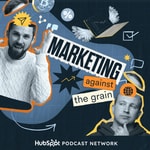Sports CDP Crash Course - Data Talks – Détails, épisodes et analyse
Détails du podcast
Informations techniques et générales issues du flux RSS du podcast.

Sports CDP Crash Course - Data Talks
Data Talks
Fréquence : 1 épisode/7j. Total Éps: 149

Classements récents
Dernières positions dans les classements Apple Podcasts et Spotify.
Apple Podcasts
🇬🇧 Grande Bretagne - marketing
30/12/2024#61🇬🇧 Grande Bretagne - marketing
03/10/2024#81🇬🇧 Grande Bretagne - marketing
02/10/2024#46
Spotify
Aucun classement récent disponible
Liens partagés entre épisodes et podcasts
Liens présents dans les descriptions d'épisodes et autres podcasts les utilisant également.
See all- https://foundationinc.co/
25 partages
- https://sportingsheroes.bio.link/
25 partages
- https://lewesfc.com/
18 partages
- https://twitter.com/NancyAHensley1
2 partages
- https://twitter.com/womeninfootball
2 partages
- https://twitter.com/yvonneh147
2 partages
Qualité et score du flux RSS
Évaluation technique de la qualité et de la structure du flux RSS.
See allScore global : 52%
Historique des publications
Répartition mensuelle des publications d'épisodes au fil des années.
#144 The time for women's sports to harness the power of data is now
Saison 3 · Épisode 144
mardi 1 octobre 2024 • Durée 07:09
Today I want us to do something different. Instead of talking about the future of women’s sports, I want us to dream about it, together. And not a future in the next coming 5 years, but rather, a future that happens in a mere 14 months, at the end of nex year.
"It’s December 15, 2025. We’re here, watching a sold-out stadium filled with thousands of passionate fans, all draped in the vibrant colors of their favorite women's sports team. This isn’t a dream—it’s the future of women's sports, and it's happening right now. The stands are packed, and excitement is radiating through the air. Everyone is on the edge of their seats, anticipation building as the game kicks off. But there’s something deeper at play here than just the action on the field—something that has transformed women’s sports forever. And it all comes down to one thing: data."
"Today, every single one of those fans has been a part of a carefully crafted experience. The club didn’t just sell tickets and hope for the best—they used data to get to know their fans, to understand what they love, and to make sure this experience is unforgettable. And that’s why, game after game, season after season, these same fans keep coming back. Women's sports have always had the heart, the passion, the talent. Now, they’re proving to the world they can deliver the profits too."
"Let’s break it down. When we talk about 'harnessing data,' we’re not just talking about numbers. We’re talking about deep insights into who these fans are, what makes them tick, and how clubs can connect with them in meaningful ways. With data segmentation, women’s sports clubs can categorize their fans based on behaviors, preferences, and spending habits. It’s like having a crystal ball that tells you exactly who’s most likely to buy tickets for the next big match, or who’s going to jump at the chance to snag exclusive merchandise."
"And then, there’s gamification. Look around this stadium—it’s not just a place to watch sports; it’s a playground for fans. Before today’s match, thousands of fans played a score prediction game on their phones, eagerly inputting their guesses and earning points. Not only did it build anticipation, but the club now has something even more valuable—the fans’ contact details, and insights into their behavior. Data like this turns casual spectators into die-hard supporters who come back, time and again. Fans feel like they're part of something bigger, and they’re more likely to engage in the future."
"Now, let’s talk about the numbers that prove just how powerful this transformation has been. Research shows that women's sports fans have a higher purchase intent compared to their male counterparts. In fact, a Nielsen study found that 84% of women’s sports fans are more likely to purchase a product because it sponsors women’s sports, compared to 68% of general sports fans. This isn’t just about loyalty—it’s about a fanbase that is willing to spend, and spend big, to support the teams and brands they love.
And it doesn’t stop there. Women’s sports fans are more engaged online, too. Clubs that have embraced data are seeing exponential growth in social media interactions, website traffic, and digital engagement. Fans are staying connected year-round, not just during the season."
"Fast forward to next season. Picture this—those same fans, now back in their seats, eagerly awaiting the kickoff of another unforgettable game. They’re not just here because of loyalty; they’re here because the club knows them. They receive personalized offers, exclusive content, and VIP experiences tailored specifically to their preferences. The club uses data to make sure every touchpoint, from the moment they purchase their ticket to the moment they leave the stadium, is seamless and unforgettable.
And the beauty of it all? This is just the beginning. Women's sports are proving that with the right tools, they can compete on every level—bringing in...
#143 How data is the key to unlocking a deeper emotional connection with fans
Saison 3 · Épisode 143
mardi 24 septembre 2024 • Durée 09:13
Today, we’re talking about something that’s absolutely essential – understanding the emotional connection with fans and how using data in a more personal way can drive not just engagement, but lasting loyalty and growth and how you are going to learn about all of this and more at the Data ‘Talks’ Revenue Conference.
Being in a sold-out sports event is an overwhelming sensory and emotional experience. From the moment you step into the stadium, there’s an electric energy in the air that feels almost tangible. The hum of thousands of conversations, the constant buzz of excitement, and the occasional roar of a chant rising from the crowd wash over you as you find your seat. You can feel the anticipation building, almost like static electricity, as fans from all corners of the stadium unite in their passion for the game.
At times, the crowd falls into a tense silence, but even then, there’s a crackling energy that hovers in the air, as if everyone is holding their breath, waiting for the next moment to explode.
"When dealing with people, remember you are not dealing with creatures of logic, but with creatures of emotion." These are the wise words of Dale Carnegie. This sentiment cuts right to the heart of why personalising your fan engagement strategies is so important. Fans, especially in sports, don’t just make decisions based on logic or pure reasoning. They are driven by emotion – the thrill of victory, the pain of defeat, the pride in their team, the connection with their favourite players. In sports, emotions run deep, and that’s what makes this industry so unique.
Nudge theory, developed by behavioural economist Richard Thaler, tells us that people can be "nudged" into making certain decisions or behaviours through subtle changes in how choices are presented. And it’s not about making people do something; it’s about gently guiding them, often by tapping into their emotional triggers.
Think about it this way: if you want fans to attend more matches, buy more merchandise, or sign up for exclusive memberships, you need to nudge them toward those actions. You do that by making it emotionally compelling and easy for them – not just telling them logically why it’s a good idea. This is where data comes in, and it’s more crucial now than ever.
With the right data – and I mean personal data – you can understand what really motivates your fans. You’re not just treating them as one large group of people who love football or rugby; you’re treating each fan as an individual with unique preferences, passions, and emotional drivers.
This is where sports organisations can truly elevate their strategy. By using a Customer Data Platform (CDP) like Data Talks, clubs can bring together all the fan data in one place. This allows them to not just track who’s attending games or buying merchandise, but also to understand what resonates with individual fans: their favourite players, the games they never miss, or even the emotional moments they care about most.
When you have that data, you can personalise your communications, offers, and experiences. Instead of sending a generic email about the next home game, you send a personalised message to a fan who always attends derby matches, reminding them of how important their support is for that specific game. It’s a subtle nudge, but it works – because you’ve tapped into their emotions.
And why is this even more important in sports than in other industries?
Well, sports fandom is inherently emotional. Unlike other businesses where customers might be more logical in their choices, sports fans are loyal, often for life. They identify with the clubs they support, emotionally investing in every win, every loss, every season. This gives sports organisations a unique advantage – but it also means you need to be more thoughtful about how you engage them. You can’t rely on rational messaging...
#134 In conversation with Kirsty Burrows - Making safeguarding and mental health part of the DNA of sports
Saison 3 · Épisode 134
mardi 23 juillet 2024 • Durée 45:58
We’re thrilled to welcome Kirsty Burrows, Head of the Safe Sport Unit at the International Olympics Committee, to today’s episode. Kirsty’s impressive credentials include serving as the IOC Lead Safeguarding Officer at Games-time, Academic Director of the IOC Certificate: Safeguarding Officer in Sport, member of the Council of Europe’s Pool of Experts in Safe Sport, and author of the IOC Safeguarding Toolkit (2017).
In this insightful conversation with Lorraine Moalosi, Kirsty discusses the importance of embedding safeguarding into an organization’s DNA rather than viewing it as an abstract concept. She also addresses the challenges faced by international organizations in enforcing safeguarding measures globally and offers practical advice for sports organizations aiming to integrate safeguarding into their culture and operations.
This special episode highlights the essential role of safeguarding in sports and reminds us of the people behind the extraordinary achievements at the Olympics.
#44 Why you should leverage social media and make it a key component of your sports marketing strategy
Saison 1 · Épisode 44
mardi 1 novembre 2022 • Durée 05:34
We are continuing with our “10 components you need to include in your sports marketing strategy today” series and today’s focus is on leveraging your social media platforms. This is the 6th component we are discussing so if you have missed the first 5, make sure to listen to those too.
According to Nielsen, 47% of people who watch sports on TV or via digital platforms simultaneously watch other live content. Among these different multi-screen viewing activities, social media engagement makes up 32% of this total number. And this number is even higher for Gen Z, where social media stands for 46% of their viewing activities. So it then goes without saying: making social media a part of your sports marketing strategy should be a given. By being present and playing an active role in your supporters’ favorite social media platforms, you are able to:
- Open a window into the lives of your supporters and understand their specific needs, preferences, and behaviors.
- Maximize fan engagement by interacting with them on social media, for instance via accounts that belong to your club or athletes.
- Leverage the social media data you have collected about your supporters to find and create new monetization opportunities.
However, there is a huge mistake that most sports organizations make when it comes to social media. From small clubs to big ones such as FC Barcelona, this mistake is indeed a common one. Many sports organizations actually make the mistake of not converting their followers into contacts in their database. Let’s take FC Barcelona as an example. Out of more than 350 million social media followers, Barcelona only had less than 3 million contacts.
Not converting your social media followers to contacts in your database can limit your sponsorship value and the effectiveness of your communications. So you won’t be able to segment or target effectively, personalization becomes near impossible if you don’t understand your fans. And you can’t understand your fans if they are not even in your contact database.
So how can you make sure that you increase your social media followers while simultaneously growing your contact database? Remember we said that content is king? That’s what you need to leverage to grow your social media followers and contact database. However, it is crucial that you direct your social media followers to one of your own platforms. Here are a few examples of such content:
- Giveaways where your supporters have to sign-up and leave their contact information
- Another amazing way you can grow your contact database is to run competitions
- Promote gated content on your social media. This will require fans to once again, sign-up in order to access the content
- Subscriptions are another fantastic way of gaining more followers while growing your contact database. Do you have a newsletter or a blog? Are you maybe a bigger organization with a digital newsroom or do you offer regular public relations communications? Then why not create a subscription call to action? Something along the lines of, “subscribe to our newsletter and never miss a thing we do ever again”.
- Give discounts and vouchers - Everyone loves discounts and vouchers, especially nowadays where “entertainment” is becoming more expensive and sports tickets are becoming more and more expensive. So why not offer your followers discount codes if they sign up for something on your website or any other platforms you own?
In summation, leveraging social media is crucial for every sports organization’s growth.
#43 In conversation with Soleen Al-Zou'bi - Follow your passion and success will follow you
Saison 1 · Épisode 43
mardi 25 octobre 2022 • Durée 25:42
Meet Soleen Al-Zou'bi
Head of Women’s Football & Assistant Technical Director at Jordan Football Association and Co-founder and president of Finaa Organization - a non-profit organization that empowers girls and women through football. Soleen is also a Women’s Football Committee member and Youth Panel member at the Asian Football Confederation (AFC).
We sat down with Soleen to discuss:
- The importance of following your passion
- The growth of women's football in Jordan
- The future of football
You can connect with Soleen on LinkedIn and if you would like to join Soleen and other fantastic women in sports in a community specially made for advancing women's sports, you can do by joining our community so you never miss a thing.
#42 Why you should prioritize OTT as part of your sports marketing strategy
Saison 1 · Épisode 42
mardi 18 octobre 2022 • Durée 05:00
Today we are focusing on why you should prioritize Over the top streaming (OTT) platform as part of your sports marketing strategy. This is the 5th component out of the ten that we will be deep diving into as part of our “10 components you need to include in your sports marketing strategy today”. If you missed the first five, be sure to listen to those as well.
Unlike traditional TV, an OTT platform allows sports organizations to offer streaming content to their supporters via their preferred devices, such as mobile phones or tablets. According to Nielsen’s 2022 global sports marketing report, “as connected devices gain momentum as the great amplifier of content, access to content continues to expand, with 40.7% of global fans now opting to stream live sports events through digital platforms.” This simply means that the usage of OTT will only keep on growing.
OTT is a compelling component to include in your sports marketing strategy especially if you are:
- A women’s sports organization - We have often spoken about the lack of visibility for women in sports here on this blog. Thanks to the advent of digital platforms such as social media and over-the-top (OTT) streaming platforms, women's sports were estimated to gain a 96% increase in visibility. Here are a few examples: The UEFA, YouTube, and DAZN deal that aimed to "bring fans all over the world closer to the action than ever before". Eleven securing global rights for the Thai women's league and working with the Football Association of Thailand "to champion the competition to fans across the region and globally". Somyot Poompanmoung, president of the Football Association of Thailand was quoted saying: “We’re excited to work with Eleven on a new chapter for Thai women’s football, and this agreement will give fans unprecedented access to the Thai Women’s League domestically, across South East Asia, and worldwide. Over the next three years, we have a great opportunity to increase the visibility of the women’s game, including the ability to engage new fans via a free-to-watch game every matchday.” OTT is a perfect example of how technology can become an important way of making innovation inclusive. It solves the real issue of the lack of visibility of women's sports.
- A smaller sports organization with great ambition but not necessarily great resources such as high negotiating power with TV stations.
The benefits of using an OTT platform are many, but to name a few, using OTT can help sports organizations:
- reach a younger and wealthier audience – generation Z
- target your audience with hyper-personalized content and ads – and if you own the platform, you will also gain better data
- Retarget your supporters – OTT is a great channel to use for retargeting your supporters with ads that are relevant to them.
So if you want to create a sports marketing strategy that is successful and sustainable, as well as leverage your marketing campaigns and deliver hyper-personalized supporter experiences, then you should make your OTT platform a priority.
#41 Content is King, so make it a key component of your sports marketing strategy
Saison 1 · Épisode 41
mardi 11 octobre 2022 • Durée 05:03
An increasing number of supporters expect to receive some form of content during the off-season. Moreover, with the rapid increase in content creation and consumption across different platforms and channels, the demand for additional sports content has also grown. According to Nielsen’s 2022 global sports marketing report: “the demand for content related to a live event (match announcements, highlights, recap videos, etc.) is almost as high as it is for digitally delivered events themselves.”
That’s why this episode of the podcast is dedicated to delving deeper into the fourth component of our “10 components you need to include in your sports marketing” series. And this component is - Content is King.
The interest in sports content (both related to and not related to live sports events) is becoming more important, especially among the younger generation. This is a crucial piece of information since the same generation, Generation Z, also is the biggest global consumer cohort – with a spending power of a whopping $140 million in the US alone.
Examples of content that sports organizations can leverage to get their highest fan engagement to date, include:
- Videos centered around pre-game events, post-game events, and some behind-the-scenes footage in practice, for example
- Video on Demand content that can be delivered specially to individual supporters upon request. You can do this through both traditional television broadcasting and over-the-top streaming platforms
- Another type of content that sports organizations can leverage is content generated by the supporters themselves. This content is usually created and shared via social media, with TikTok and Twitch having the highest usage rate gains in comparison to other platforms between April 2020 – August 2021.
- Fantasy sports games are another fantastic way in which sports organizations from leagues to clubs, can use content to engage fans. Fantasy sports allow a fan to act as the owner of a team and give them the power to cut (drop), sign (draft), and trade the players of their choosing. Where points and standings are given based on an athlete's true performance in games.
There are different types of content that you can really leverage to increase fan engagement to the highest it has ever been in your sports organization. Some other types include sports scores, statistics, game summaries, sports news, photographs, video and audio files and or podcasts, and other similar sports-related information and services, in text, multimedia, or any other format.
As you can see, there is a mountain of opportunities for content creation that sports organizations can leverage and monetize.
But how can you achieve this in a way that guarantees results beyond your expectations?
By collecting relevant data about your supporters, using a Sports Customer Data Platform so you can uncover the necessary insights about your supporters in order to understand the type of content your supporters want and the channels and/or platforms they would prefer to interact with your content. Once you have uncovered these insights, you will be able to deliver hyper-personalized content to your fans from the same platform, the sports CDP.
#40 In conversation with ... August Berg
Saison 1 · Épisode 40
mardi 4 octobre 2022 • Durée 26:34
Meet August Berg an academy coach at BP FC here in Sweden. He is also a sports CDP advisor here at Data Talks with a passion for helping sports organizations engage with their fans better than ever before.
We sat down with August to discuss:
- the importance of academy football
- the challenges academy football face
- changes needed to make academy football the best it can be
- and of course, we discussed August's journey in academy football and why it was important for him to get involved in the business side of sports by working at Data Talks as a sports CDP advisor.
About Data Talks:
Data Talks helps you to create a world-class supporter experience, based on your data. With their leading-edge Customer Data Platform (CDP), you can build personalized fan engagement by collecting, analyzing, and acting on your data. First, you collect supporter data from scattered sources, such as websites, email, social media, apps, ads, plus more, into one place. Then you get a 360° profile view where you can discover valuable insights. Last but not least, you act on your insights using automated campaigns to create an outstanding supporter experience!
#39 Working data-driven as a key component of your marketing strategy
Saison 1 · Épisode 39
mardi 27 septembre 2022 • Durée 05:05
We are living in the fastest-changing communications technology landscape than ever before. New software and applications are sprouting up like mushrooms. Think about it, fifty years ago, the majority of people did not have email addresses. But nowadays it’s virtually impossible to conduct any kind of process in your sports organization without an email.
Less than twenty years ago Facebook didn’t exist. But now it has been downloaded by at least 5 billion people. That is more than 60% of the world's population. Humanity has become more technological. So, “if you can’t beat them, join them”, right?
This is where working data-driven comes into play. Whether you are a league, federation, or club, a men’s team or women’s team, no matter the region of the world you find yourself in, working data-driven is key to the success of your organization.
One of the biggest challenges to working data-driven that sports organizations face is having data stored in many different sources. For example, your merchandise stats would be on one platform while your ticketing data would be on another. This is a huge issue because:
- It takes a lot of effort and time to make sense out of your data let alone derive any kind of useful insights from it
- You can’t share this data easily with the rest of the team, especially those from other departments as you would have to individually access each source to do. Once again, quite consuming and laborious.
- It’s had to make innovative and proactive decisions about the future of your organization if you can’t really get the full picture from all your data since it’s scattered all over many sources.
So the most important step towards working data-driven is ensuring that you get a reliable single source of truth that can show you actionable insights from your supporter behavior. And this reliable single source of truth is a sports CDP. If you have already done your research and know the impressive results you can get with a CDP, today we want to give you practical tips on how to ensure that your entire organization has a data-driven culture. If you are not quite at this stage yet, don’t worry, we have you covered. We have many resources on our website to help you catch up to speed, find link in the description below.
If you want to ensure that your entire sports organization has a data-driven approach to everything, here are some practical tips:
- Start at the top - Top management needs to understand the importance of working data-driven and then embrace this fully. They need to lead by example and set that expectation of working data-driven.
- Communicate why you’re going data-driven with the rest of your team - Making changes and adopting a “because management decided so” approach does not work. Instead, you have to communicate your vision with your team.
- Improve data transparency - You simply cannot preach a culture that is unattainable. This is a strong CDP use case because a CDP keeps data organized, unified, updated, and stored in one place. Moreover, the CDP can be integrated with other systems such as your ticketing system, and Customer Relationship Management system (CRM). And this data can be shared easily with other departments and the rest of the team.
- Measure the before and after - It’s one thing to tell people that something works and it’s entirely another to show them.
- Applaud your team - Embracing change can be very difficult. So if your team has done incredibly well in implementing all the changes, you have to encourage them by celebrating them.
#38 Personalization - why you should always include this key component in your marketing strategy
Saison 1 · Épisode 38
mardi 20 septembre 2022 • Durée 05:29
We are continuing our “10 components to include in your marketing strategy series”. Today we are looking at component number 2, personalization. We will briefly discuss what personalization is, and why it’s important that you include it in your marketing strategy. But first, a couple of statistics:
- 91% of consumers say they are more likely to shop with brands that provide offers and recommendations that are relevant to them.
- 71% of consumers feel frustrated when a shopping experience is impersonal - so for a sports organization such shopping experiences including buying tickets and merchandise for example. If that experience is impersonal, 71% of your supporters will be frustrated.
So then the question becomes since consumers are adamant about getting relevant and personal experiences, how can your sports organization ensure that they do this for their fans?
That’s where personalization comes in. Personalization is the process of tailoring a service or a product to accommodate the specific needs, wants and preferences of individual supporters and/or groups of supporters. This process is crucial because it helps deliver the right message to the right supporter at the right time and through the right channel. Therefore ensuring that all your communications with your supporters are relevant and indeed personal.
Just as the statistics we began with suggest, personalization is important because it increases supporter satisfaction which is more likely to lead to an increase in their loyalty and engagement with your organization. Which ultimately leads to higher revenue. Happy fans happy days.
We have helped one of our customers, AIK, generate 6 figures with one campaign within 2 weeks targeting only 2% of their supporter base. Do you know what the secret was? Personalization. Because our customer’s communications with their supporters were relevant and personal, their supporters engaged overwhelmingly with the campaign.
In order for you to do this right, that is, continually create and deliver world-class supporter experiences that are personalized, you need a sports customer data platform. That’s what our customer built their campaign with. With the sports CDP, you can cover all your bases from beginning to end. How, well, let’s break down personalization - getting the right message to the right supporter at the right time and through the right channel.
- To get the message you are sending to your supporters right, you need to first understand them. A CDP provides you with a 360-degree supporter view that helps you understand your supporters in and out. This 360-degree supporter is only fully possible with the CDP and no other software.
- Secondly, just because you have a message does not mean that message is appropriate for everyone. A CDP will help you understand which message to send to which supporters.
- Thirdly, timing is everything. Could you imagine sending your supporter an email asking them to buy a season ticket when they have just purchased one? Your organization would come across as pushy. A CDP will help you know when to send your communications so you can always get the timing right.
- And finally, some supporters prefer buying tickets online while others prefer buying offline. A CDP will help you figure out the right channel to reach your supporters through.
That is what we mean when we say, get the right message to the right supporter at the right time and through the right channel - the very definition of personalization. And just like our customer AIK understood, the sports CDP is your best friend if producing results beyond your wildest expectations through personalization is what you want.
Try our DEMO for free today!









